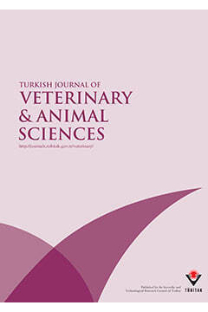Prevalence of Cryptosporidium spp. infection and its relation to other enteric pathogens (Escherichia coli K 99 and rotavirus) in cattle in Ankara, Turkey
Faecal samples of 172 diarrhoeic and 130 non-diarrhoeic cattle were examined for the presence of Cryptosporidium oocysts. The prevalence of infection in diarrhoeic and non-diarrhoeic cattle was 63.3% and 69.2%, respectively. The infection was prevalent in cattle over three years old, in both diarrhoeic and non-diarrhoeic animals. In both groups, oocyst sheeding level of (+) was the most common. Cryptosporidium-positive faecal specimens were examined for the presence of Escherichia coli K 99 and rotavirus. E. coli K 99 was isolated from the faeces of 35 (32.1%) diarrhoeic and 23 (25.5%) non-diarrhoeic animals. Rotavirus was not detected in any of the faecal samples.
Anahtar Kelimeler:
Cryptosporidium, prevalence, cattle, E. coli K 99 and rotavirus
Prevalence of Cryptosporidium spp. infection and its relation to other enteric pathogens (Escherichia coli K 99 and rotavirus) in cattle in Ankara, Turkey
Faecal samples of 172 diarrhoeic and 130 non-diarrhoeic cattle were examined for the presence of Cryptosporidium oocysts. The prevalence of infection in diarrhoeic and non-diarrhoeic cattle was 63.3% and 69.2%, respectively. The infection was prevalent in cattle over three years old, in both diarrhoeic and non-diarrhoeic animals. In both groups, oocyst sheeding level of (+) was the most common. Cryptosporidium-positive faecal specimens were examined for the presence of Escherichia coli K 99 and rotavirus. E. coli K 99 was isolated from the faeces of 35 (32.1%) diarrhoeic and 23 (25.5%) non-diarrhoeic animals. Rotavirus was not detected in any of the faecal samples.
Keywords:
Cryptosporidium, prevalence, cattle, E. coli K 99 and rotavirus,
- ISSN: 1300-0128
- Yayın Aralığı: Yılda 6 Sayı
- Yayıncı: TÜBİTAK
Sayıdaki Diğer Makaleler
Ayşen ZOHOURI, Süleyman K. TEKELİ, Ahmet MENGİ
Peptide Profile of Low-Fat Edam Cheese
Splenic hemangiosarcoma with abdominal dissemination in a dog
The Coccidia of the Gallinaceous Birds in Azerbaijan
Musa MUSAEV, Gamida GAIBOVA, Galiba ISMAILOVA, Farida ALIEVA, Naila ISKENDEROVA
Mutlu SEVİNÇ, Abdullah BAŞOĞLU
Ahmet G. ÖNOL, Sakine YALÇIN, Sulhattin YAŞAR, Adnan ŞEHU
İsmail MERAL, Ali ÇINAR, Fahri BAYIROĞLU
